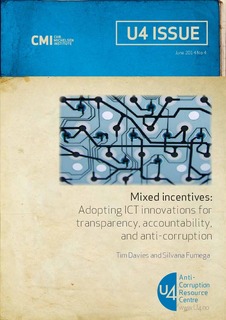| dc.contributor.author | Davies, Tim | |
| dc.contributor.author | Fumega, Silvana | |
| dc.date.accessioned | 2018-01-04T08:19:05Z | |
| dc.date.available | 2018-01-04T08:19:05Z | |
| dc.date.issued | 2014-06-17 | |
| dc.identifier | oai:www.cmi.no:5172 | |
| dc.identifier.citation | Bergen: Chr. Michelsen Institute (U4 Issue 2014:4) 38 p. | |
| dc.identifier.uri | http://hdl.handle.net/11250/2474950 | |
| dc.description.abstract | Governments adopt anti-corruption-related ICT innovations for many reasons. Different motivations for adopting these technologies shape the way they are put into practice and the anti-corruption impacts they may have. ICT for anti-corruption should not be understood as a single approach, since different technologies, and different modes of technology adoption, create different dynamics. Whether or not a particular ICT can bring anti-corruption benefits will depend upon the design of a specific implementation, the incentives driving its adoption, and the wider context in which it is applied. This issue paper raises critical questions for policy makers, funders, and advocates to consider when seeking positive anti-corruption impacts from ICTs. | |
| dc.language.iso | eng | |
| dc.publisher | Chr. Michelsen Institute | |
| dc.relation | U4 Issue | |
| dc.relation | 2014:4 | |
| dc.relation.ispartof | U4 Issue | |
| dc.relation.ispartofseries | U4 Issue 2014:4 | |
| dc.relation.uri | https://www.cmi.no/publications/5172-mixed-incentives | |
| dc.subject | Anti-Corruption Approaches in Sector Work | |
| dc.subject | Brazil | |
| dc.subject | India | |
| dc.subject | Kenya | |
| dc.title | Mixed incentives: Adopting ICT innovations for transparency, accountability, and anti-corruption | |
| dc.type | Research report | |
